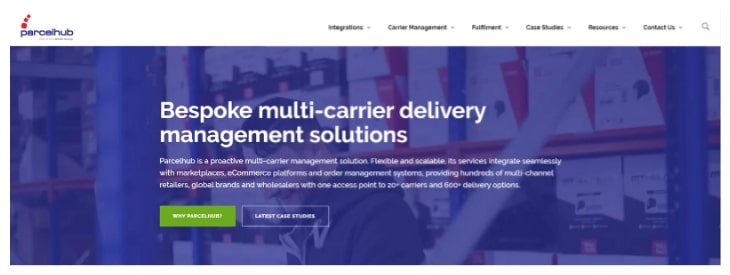This week’s guest blog is written by our new integration partners, Parcelhub.
Very, ASOS, Beauty Bay and many other retailers are starting to offer a new way to buy stuff prompted by the growing shift to ecommerce: buy now, pay later. In essence, the consumer purchases the goods, has them delivered and is then billed for what they don’t return within a set timeframe, usually 30 days. The move is designed to help shoppers who want to buy apparel online – so that they can get several styles and sizes to overcome the inability to try things – but it also is starting to be seen across the ecommerce spectrum. Research conducted found that a quarter of retailers plan to offer it by 2019, while three quarters of shoppers say they want to use it.
In fact, it is also being trialled by real-world retailers in an attempt to attract shoppers back in store: find what you want, take it away, assess it and either keep or send it back – again being billed for just the items that are kept or not returned within a given time period. Payments providers, such as Klarna, are all over this, rolling out the payment systems to retail clients that allow for the expedient management of this process – which has obvious fraud risks for retailers. But what about the impact on delivery and returns management? While it may be a boon to shoppers, for carriers it is going to mean not only more delivery journeys and more pickups, but also an increasingly complex management headache.
So what are the challenges for carriers as ‘buy now, pay later’ takes off and how can they be overcome?
Delivery
The obvious place this change in how people shop is going to have is on delivery. The whole idea of buy now, pay later – or try-before-you-buy – revolves around letting shoppers buy many things, online and offline, getting them delivered, trying them on and then returning the ones they don’t want. That means more stuff moving about. With studies predicting that on average shoppers are going to buy seven things and keep one, that could mean a seven-fold increase in the amount of goods out for delivery.
This has obvious inventory costs and inventory management and control issues for retailers, but it also produces a massive shipping conundrum. While we shall come to the returns element in a moment, the prospect of a massive increase in shipping volumes makes it more important than ever to engage in logistics management and customer service – ideally through third parties, as the volume is set to be sky high. With ecommerce increasing, this new way to shop is going to push delivery to the limit – and most retailers simply aren’t ready for the volume and the complexity of the task at hand. Never has it seemed so pertinent to engage a third party logistics firm: they have the flexibility and carrier connections to make this increased shipping demand work.
Returns
The biggest headache for delivery companies – and retailers – are returns. According to a recent study, 87% of consumers would return up to seven purchases – with research showing that 85% of them expect retailers to provide returns for free. The idea of free or cheap returns is already encouraging customers to deliberately over-order, with more than 40% of retailers having seen a marked increase in ‘intentional returns’ over the past 12 months, according to the research. The study also finds that half of retailers (51%) say margins are being heavily impacted by handling returns and 72% believe the problem will only get worse thanks to try before you buy. 17% of global retailers have already adopted the try-before-you-buy model. By 2019, more than a quarter will offer this type of service to customers. However more than two-thirds of retailers (69%) are not deploying any technology solutions to process returns, according to the study.

This is despite the complexity of managing returns, with the average returned purchase passing through seven people before it’s listed for resale. The impact of all this is likely to get worse as more and more consumers and retailers adopt try before you buy options, and it seems that couriers are not ready for it – in terms of systems, technology or even money. Again, this is where a delivery management expert comes into play. All the issues a retailer has with returns are magnified in a buy now, pay later world. Merely keeping track of where goods are – stock, out for delivery, being held by customer (for up to 30 days) or being returned (and indeed, where they are being returned to) – is going to be harder than ever with this form of ecommerce on steroids. Using third parties to manage this process increasingly looks like the only option. It is also one of the few ways to get a handle on the likely costs of returns before implementing a try-before-you-but offering to consumers.
Keeping on tracking
Knowing where inventory is at all times is also a crucial part of the process – and with potentially more of it out there either being tried on or being sent back, understanding where that all is, is crucial to both retailer and carriers. The key thing is to integrate whatever shipping management tools – of the shipping management tools of any third party shipping experts that you use – into your selling platform. This not only means plugging it into the ecommerce system and logistics systems a retailer has in place, but also into any marketplaces. Right now the try-before-you-buy option isn’t available on marketplaces: but if it takes off to the extent that many feel in will, then they too will probably start letting some key retailers in certain segments offer it.
Knowing what is where in the chain used to involve just looking at sales, out for delivery or on the way back. Now it means looking at how it was bought, the timeframe before it may be returned, what other items of that order may have been returned and your own returns policy. Investment in returns here is going to be vital – even if you never offer buy now pay later, you can’t go wrong with a really strong returns process.
The High Street
With High Street stores joining the fray, the challenges for suppliers and carriers become more complex. Traditionally, High Street stores accepted returns in person, but a move to integrate online and real-world shopping – a must if the High Street chains are to survive – probably means that try-before-you-buy options are going to involve personal purchase and courier return, and vice versa. In some ways this is good news for the shipping industry: it opens up a whole new market to tap into. However, it adds yet more cost and complexity for retailers.

For instance, will returns be free? Will the courier go pick them up from the customer or does the customer have to use a collection point – and if so where is that and who runs it? Where will these returns go to: back to the store from whence they came, or a central distribution centre for redistribution? Much has to be worked out to make it work and, again, third party delivery management firms are going to be the beneficiaries. They can tap into retailers in the real world and run this process for them. Properly creating and managing such a collection system – or even insisting that items are brought back in person if bought in person – is going to be key. Third parties can help work out how best to do this, manage the process of using multiple carriers to do it with and cost it out before you start.
Costs, challenges and conclusions
It is still very early days with ‘buy now, pay later offerings’, but with some major retailers already behind it, it is gaining traction. The cost implications of putting it in to practice are not inconsiderable, but with many seeing this as one way to boost sales in the face of Amazon eating everyone’s lunch and, for the High Street, a last shot at trying to bring the online and offline retail worlds together, it is likely to come to pass. It will have a profound effect on delivery volumes, but the real issue will be around returns and stock management. Factoring the cost of delivery and returns is one thing, but allowing for the cost of what could be 80% of stock being out and about at any given time is going to be huge.
There is also the cost of repackaging and preparing for sale all those returned goods, many of which have been tried on a rejected. It may be a sweetener to deliver more sales, but it is certainly a costly one. Clearly, Very, ASOS et al have all managed to mitigate this – in the case of ASOS by charging a £9.99 annual fee for ‘joining’ ASOS – but it is a very real cost. When the costs of handling the greatly increased movement of goods from place to place, the installation and management of collection points or services and more are factored in it is pricey. Finding partners to work with to manage the delivery and return aspects is one way to at least understand and manage the costs of part of the process. If you can work with logistics suppliers and third party delivery management specialists, the logistical aspects of buy now pay later can be controlled.
About Parcelhub – The bespoke parcel shipping solution.
Parcelhub is a multi-carrier shipping and ecommerce customer services solution. Flexible and scalable, it integrates seamlessly with marketplaces, ecommerce platforms, OMS, WMS and ERP systems, providing hundreds of multichannel retailers, global brands and wholesalers with one access point to 20+ carrier partners and 300+ services.

Distributing more than 6 million parcels on its own carrier contracts every year, Parcelhub’s free multi-carrier shipping software grants hundreds of national and global businesses access to ‘pooled volume’ discounted rates from its carefully selected range of carrier partners, including Yodel, Hermes, DPD, UK Mail, DHL, Whistl, UPS, DX, Parcelforce, CollectPlus, SkyNet, ArrowXL, Interpost, Panther Logistics, Direct Link and Palletforce. Dedicated proactive parcel management comes as standard.


